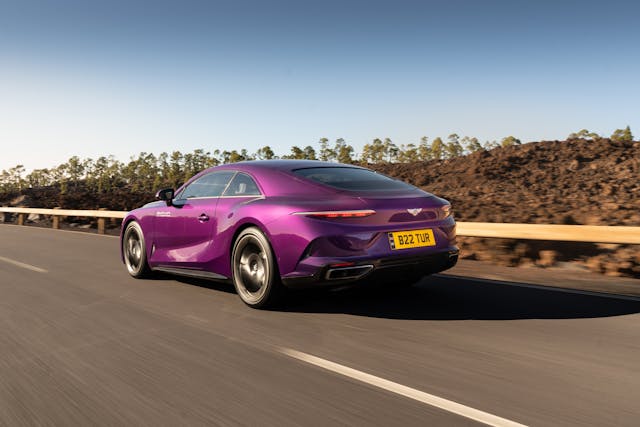Media | Articles
Why the $2.1M Bentley Batur matters more than you’d guess
To hear Bentley’s president and CEO Adrian Hallmark tell it, the new $2.1 million Bentley Batur signals an entirely different way to build cars. The shorthand, which is far more complex in reality, meant taking the existing Continental GT Speed’s “perfect proportions, but to then do a study in surfacing and volume.” Not a study introduced in a studio back in Crewe, England, at Bentley’s HQ, with designers, execs, and engineers huddled around a giant screen projecting the concept, but a 3D rendering set out before a select few would-be Bentley buyers, so that the carmaker might solicit input.
That idea, of letting customers into the room before a car is ever produced, with their own Sharpies, their own proclivities and wants, really began with the prior car, the topless Bacalar made by Mulliner, the taste-making arm of Bentley. Only 12 of those were sold, but the experiment was a dart in the dark that nailed a bullseye, according to Hallmark. Those cars signaled to execs that Bentley could bring its business up to, if not quite Ferrari per-vehicle-ka-ching! levels, at least to a rung well beyond VW Group stablemate Lamborghini. When we sat down to discuss the Batur at the Quail Motorsports Gathering at Monterey Car Week, Hallmark was eager to make this idea as clear as possible.

“Twenty years ago, when we launched the GT, sure, we’d do a few bespoke cars here and there. One or two royals in far and distant places would buy those, but then they’d stash them away and they’d never see the light of day. We could never make a business out of it.” Hallmark said even a decade back Bentley would look at what Ferrari was doing and wonder how to match it. “Our most personalized Mulliner cars are about a half-a-million dollars. How do we reach the most successful people in the world? We know they’re car crazy, but we also don’t make sports cars.”
The answer wasn’t as simple as you might think. First, there’s a serious problem, even for Ferrari, called homologation. The Batur is a riff on the Continental GT, so it cannot drift too far afield from that, since that would cost tens of millions in crash-testing and fresh federalization worldwide—and far too many months in delay to market. Quietly, Bentley also needed that red-tape hedge—to not put their customers and themselves at risk of some sort of clean-sheet concept run amok. The GT has, after all, sold tremendously well and is valued for what it looks like. “We have golden ratios for the car already,” Hallmark glowed. “If you look at the height of the car to the length, the windows to the body, the height of the top of the fender to the wheel… its ratios are pretty great right the way through.”


So, sure, add not getting that wrong to the ledger of wants. And while you’re ticking that box there’s Mulliner’s history, too. Prior to the Bacalar, at Bentley Mulliner meant custom paint, trim, stitching, dashboards, and other “jewelry,” but not genuine re-bodying. Even though Mulliner dates to the 1700s and built actual horse-drawn carriages. And unlike, oh, Rivian or Lucid, et al, Bentley really has this heritage, so restoring that part of the business was a long-held dream.
But the Batur could be yet more, Hallmark stressed. It could signal both the future design direction of the carmaker as it switches to electrification, and also show two different “channels” of Bentley—the bespoke and off-the-rack. The former, too, could also prove out certain ideas well before mainstreaming. “We could say to these new buyers, ‘Instead of doing concept cars that cost us money, we do these few and if it works, you buy them, and we take some of those elements and bring them into the future.’”
To this notion Mulliner’s director, Ansar Ali, who we talked to separately, makes the point that this idea of low-run cars as road-going labs for future product is far smarter than racing, too, “because you can make an excellent business case.” One example Ali cited: The Batur’s carbon fiber is made from a new process that includes flax and natural resin, that is far less polluting, and Ali says the goal was to experiment with that in low volumes so they could eventually convert it into a larger-scale system.

But what about the actual execution? The actual whiteboard work with newbie buyers?
“We just told customers we wanted to make the ultimate GT,” Hallmark said. “We told them there’d be more horsepower, more torque, then a full carbon fiber body.” Then they got to engage in what he calls the “ultimate surfacing exercise. We kept the proportions, but it was, metaphorically speaking, a sanding away.” That results in a car where the body is smoother, the headlight surrounds are pinched, and even if there are oval projectors behind the housings, the upward squint is a serious departure from Bentley’s signature wide-eyed visage. From the side, the shoulder line of the GT remains, but a single hard crease and more pronounced bulge down the bodyside announce a bolder presence, as does a bulkier, more rounded rump that doesn’t slope away as quickly. Crucially, too, “it doesn’t cost us three times as much to build,” Hallmark added, because that would eviscerate the entire reason to produce cars this way.
We only got a short taste of actually driving the Batur, and it was at a fairly slow pace around Monterey, but even then you could tell that a 5 percent weight loss, thanks to the lighter skin, resulted in a more lively feeling ride. How much faster or more fun it might be than the Speed, you’d only be able to discern on the track, and besides, this is definitely an exercise in exclusivity more than any other discernible attribute.
Speaking of that, Hallmark said of course there’s exceptional customization and exclusivity, beyond the bodywork, such as 18-carat gold switchgear surrounding the start/stop button that happened to be 3D printed and, should you want it, a $35,000 system from Naim audio that isn’t produced for Bentley’s other customers. If the rest doesn’t appeal—getting one of the last W-12 motors on earth, now pumped up to produce 740 hp and 738 pound feet of torque capable of warping you to 209 mph—Hallmark isn’t bothered. The hyper-bespoke model is working.
“We’ve created this super loyal base—customers who never bought Bentleys before. And in three years we’ve sold 100 $2 million cars—we’d never sold one until three years ago.” He brings up one new fan who, on the strength of the Batur, “now got the Bentayga Speed, too, and when he knew that the 12 cylinder runs out next year, they came over and he and his wife spec’d two additional cars.”
What all that means to the bottom line, Hallmark almost says, but isn’t that crass, is that Bentley can certainly deploy more gold and custom carbon fiber for future Bentleys down the line. And as long as Mulliner keeps making very small runs of custom editions, all these new Bentley buyers will probably be just fine if they run on electricity, too.
***
Marketplace
Buy and sell classics with confidence
Check out the Hagerty Media homepage so you don’t miss a single story, or better yet, bookmark it. To get our best stories delivered right to your inbox, subscribe to our newsletters.





































